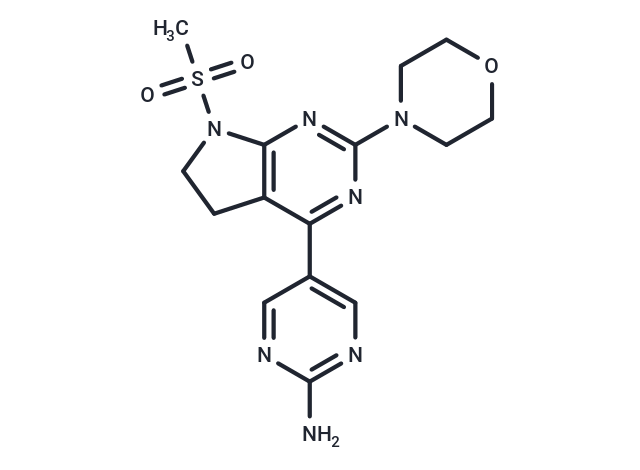Shopping Cart
- Remove All
 Your shopping cart is currently empty
Your shopping cart is currently empty

CH5132799 has been used in trials studying the treatment of Solid Tumors.

| Pack Size | Price | Availability | Quantity |
|---|---|---|---|
| 1 mg | $58 | In Stock | |
| 2 mg | $88 | In Stock | |
| 5 mg | $147 | In Stock | |
| 10 mg | $239 | In Stock | |
| 25 mg | $443 | In Stock | |
| 50 mg | $655 | In Stock | |
| 100 mg | $932 | In Stock | |
| 500 mg | $1,880 | In Stock |
| Description | CH5132799 has been used in trials studying the treatment of Solid Tumors. |
| Targets&IC50 | PI3Kβ:0.12 μM, PI3Kα:14 nM, PI3Kγ:36 nM, PI3Kδ:0.50 μM |
| In vitro | CH5132799, used as a clinical backup, exhibits high oral bioavailability (101% in mice), stability in human liver microsomes, and in vivo antitumor activity. This compound displays favorable oral bioavailability across different species including mice, rats, monkeys, and dogs (F: 54.2-101%). In a heterotrophic transplant mouse model of human breast cancer (KPL-4: PI3Ka H1047R), oral treatment with CH5132799 (12.5 mg/kg, q.d.) demonstrated significant tumor reduction. Additionally, CH5132799 shows effective in vivo antitumor activity in various heterotrophic transplant models bearing different PIK3CA mutation loads. |
| In vivo | CH5132799 effectively inhibits the phosphorylation of Akt and its direct substrates, including PRAS40 and FoxO1/3a, as well as downstream factors (such as S6K, S6, and 4E-BP1), in KPL-4 breast cancer cells harboring PIK3CA mutations. Cancer cell lines with PIK3CA mutations are notably sensitive to CH5132799, which demonstrates significant antiproliferative activity in human tumor cell lines with activated PI3K pathways due to mutations. CH5132799 selectively inhibits Class I PI3Ks with IC50 values of 0.014 μM for PI3Kα, 0.12 μM for PI3Kβ, 0.50 μM for PI3Kδ, and 0.036 μM for PI3Kγ, showing weaker inhibition of Class II and III PI3Ks and mTOR, and no inhibitory activity against 26 other protein kinases (IC50 > 10 μM). Compared to wild-type PI3Kα, CH5132799 exhibits stronger inhibitory activity against oncogenic mutants E542K (IC50 = 6.7 nM), E545K (IC50 = 6.7 nM), and H1047R (IC50 = 5.6 nM) of PI3Kα. |
| Kinase Assay | PI3K Assay: The E542K, E545K, and H1047R mutants of PI3Kα are prepared with an overlapped extension-polymerase chain reaction. Glutathione S-transferase-tagged PI3Kα mutants and His-tagged p85α are co-expressed with BAC-TO-BAC Baculovirus Expression System. The inhibitory activities of CH5132799 on PI3Kα (p110α/p85α), PI3Kβ(p110β/p85α), PI3Kδ (p110δ/p85α), PI3Kγ (p110γ), PI3KC2α, PI3KC2β, Vps34, and PI3Kα mutants are determined by Adapta Universal Kinase Assay Kit. Time-resolved fluorescence is measured with an EnVision HTS microplate reader. IC50 values are calculated using XLfit. |
| Cell Research | The cell lines are added to the wells of 96-well plates containing 0.076 to 10,000 nM CH5132799 and incubated at 37 °C. After 4 days of incubation, Cell Counting Kit-8 solution is added and, after incubation for several more hours, absorbance at 450 nm is measured with Microplate-Reader iMark. The antiproliferative activity is calculated by the formula (1- T/C) × 100 (%), in which T and C represent absorbance at 450 nm of the cells treated with CH5132799 (T) and that of untreated control cells (C). The IC50 values are calculated by using Microsoft Excel 2007. (Only for Reference) |
| Alias | lzorlisib |
| Molecular Weight | 377.42 |
| Formula | C15H19N7O3S |
| Cas No. | 1007207-67-1 |
| Smiles | CS(=O)(=O)N1CCc2c1nc(nc2-c1cnc(N)nc1)N1CCOCC1 |
| Relative Density. | 1.58 g/cm3 |
| Storage | Powder: -20°C for 3 years | In solvent: -80°C for 1 year | Shipping with blue ice. | ||||||||||
| Solubility Information | Ethanol: < 1 mg/mL (insoluble or slightly soluble) DMSO: 1 mg/mL (2.65 mM), Sonication is recommended. | ||||||||||
Solution Preparation Table | |||||||||||
DMSO
| |||||||||||

Copyright © 2015-2025 TargetMol Chemicals Inc. All Rights Reserved.